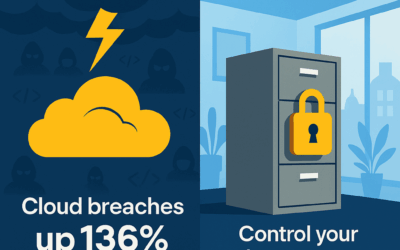Did you know that over 60% of businesses in the UK faced compliance challenges in the past year? As we move closer to 2025, the intersection of data privacy and document management has never been more critical. With evolving regulations and heightened consumer expectations, staying secure is no longer optional—it’s essential.
The GDPR continues to shape how businesses operate, ensuring data protection remains a top priority. Modern systems are now acting as guardians of compliance, helping organisations navigate this complex landscape. But what happens when businesses fall short? The consequences can be severe, from hefty fines to reputational damage.
In this article, we’ll explore actionable strategies to balance security with operational efficiency. Whether you’re a small business or a large enterprise, it’s time to take control. For expert advice, call us at 01647 750404.
Key Takeaways
- Over 60% of UK businesses faced compliance challenges recently.
- GDPR continues to influence data protection practices.
- Modern systems are essential for maintaining compliance.
- Non-compliance can lead to significant financial and reputational risks.
- Actionable strategies are available to balance security and efficiency.
Understanding the Importance of Data Privacy in 2025
By 2025, the importance of safeguarding sensitive information will reach unprecedented levels. With 75% of the global population expected to be under privacy regulations by 2024, the stakes have never been higher. Businesses must adapt to this evolving landscape to avoid severe consequences.
The Evolving Landscape of Data Protection
The GDPR has set a high standard for compliance, with fines reaching up to €20 million or 4% of global turnover. Post-GDPR, regulatory frameworks like the UK Data Reform Bill are expanding, creating a more complex environment. Staying ahead of these changes is not just about avoiding penalties—it’s about building trust.
Public sentiment is also shifting. A recent study found that 68% of consumers now prioritise privacy over convenience. This change in attitude means businesses must rethink their strategies to align with customer expectations.
Why Data Privacy is Crucial for Businesses
Non-compliance can lead to significant financial risks. In 2022, the average cost of a breach was $4.35 million, according to IBM. Beyond the financial impact, breaches can damage brand reputation, as seen in cases like Medibank and Optus.
On the flip side, demonstrating compliance can be a competitive advantage. In B2B partnerships, a strong commitment to data protection can set your business apart. It’s not just about following the law—it’s about creating value for your clients and stakeholders.
Key Principles of Data Privacy Document Management
In today’s digital age, managing sensitive information effectively is more crucial than ever. Businesses must adopt robust strategies to ensure transparency and minimise unnecessary retention. These principles not only safeguard personal data but also ensure adherence to GDPR compliance.
Transparency in Data Collection
Transparency is the foundation of trust. Under GDPR Article 5, businesses must ensure that collected information is “adequate, relevant, and limited to necessities.” This means clearly communicating why and how personal data is gathered. Implementing clear policies and providing accessible privacy notices can help build consumer confidence.
Minimising Data Retention
Retaining information longer than necessary is a common pitfall. A PwC study revealed that 63% of companies keep customer details beyond legal requirements. To address this, businesses should establish retention schedules and automate deletion processes. This not only reduces risks but also streamlines operations.
Here are some actionable steps to enhance your approach:
- Implement GDPR’s “privacy by design” through classification systems.
- Develop audit trails to track information flow across departments.
- Create detailed maps identifying storage locations and access points.
- Use redaction tools for secure sharing in collaborative environments.
By prioritising these principles, businesses can stay ahead of regulatory changes and build lasting trust with their stakeholders.
How Document Management Systems Enhance Compliance
The right systems can transform how organisations handle sensitive information. With document management systems, businesses can streamline processes while ensuring GDPR compliance. These tools not only improve efficiency but also strengthen data security.

Discovering the Type of Information You Collect
Understanding what information your business collects is the first step towards compliance. Advanced systems use AI-driven content analysis to categorise details in real-time. This reduces manual errors by 68%, according to Aberdeen Group.
By identifying the nature of the information, businesses can implement tailored strategies. This ensures that only necessary details are retained, minimising risks and enhancing transparency.
Managing and Securing Information Effectively
Once the type of information is clear, the next step is managing it securely. Role-based access controls, combined with multi-factor authentication, provide an extra layer of protection. Blockchain technology can also be used to create immutable audit trails.
Integrating these systems with existing CRM or ERP platforms ensures unified governance. Automated reporting dashboards further demonstrate compliance, making audits smoother and more efficient.
By leveraging these tools, businesses can reduce breach response times by 74%, as highlighted by Forrester. Staying compliant in 2025 is not just about meeting regulations—it’s about building trust and operational resilience.
Setting Up Retention Policies for GDPR Compliance
Effective retention policies are the backbone of GDPR compliance. They ensure that information is kept only for as long as necessary, reducing risks and aligning with legal requirements. Without these policies, businesses face significant challenges—82% of GDPR fines relate to excessive retention, according to DLA Piper.
Understanding Retention Requirements
Different types of information have varying retention periods. For example, financial records often require a 7-year retention period, while CVs should be deleted shortly after hiring. These distinctions highlight the need for tailored strategies. By understanding these requirements, businesses can avoid unnecessary risks and ensure compliance.
Implementing Automated Retention Policies
Automation is a game-changer for retention policies. It eliminates manual errors and ensures consistency across the organisation. Automated workflows can be configured with manager approval gates, adding an extra layer of control. This approach not only saves time but also enhances accuracy.
Here are some actionable steps to strengthen your retention strategy:
- Create industry-specific schedules aligned with UK and EU regulations.
- Use metadata tagging for precise lifecycle management.
- Implement legal hold protocols for litigation-related preservation.
- Conduct quarterly reviews to adapt to regulatory changes.
By prioritising these steps, businesses can stay ahead of compliance challenges and build trust with stakeholders. Retention policies are not just about following the law—they’re about creating a secure and efficient environment.
Handling Data Subject Access Requests (DSARs)
Navigating the complexities of GDPR can be challenging, especially when it comes to handling requests from individuals. These requests, known as subject access requests (DSARs), are a critical part of ensuring compliance and maintaining trust with your stakeholders.
What Are DSARs and Why They Matter
DSARs allow individuals to access the information a company holds about them. Under GDPR, businesses must respond within 30 days. Failure to comply can result in significant penalties and damage to your reputation.
With the 72-hour breach reporting window, handling DSARs efficiently is more important than ever. It’s not just about meeting legal requirements—it’s about demonstrating transparency and building trust with your customers.
Streamlining DSARs with Document Management Systems
Modern systems can significantly reduce the time and effort required to fulfil DSARs. For example, a case study by Folderit showed that using a document management system reduced fulfilment time from 28 to just 3 days.
Here are some actionable steps to streamline your DSAR process:
- Build self-service portals for initiating and tracking requests.
- Train staff to verify requester identities to prevent fraud.
- Use AI tools to redact third-party information from reports.
- Monitor SLAs to ensure 30-day response deadlines are met.
- Centralise communications to demonstrate compliance efforts.
By adopting these strategies, businesses can not only meet regulatory requirements but also enhance their overall data management processes. Efficient handling of DSARs is a clear sign of a company’s commitment to compliance and customer trust.
Preventing Data Breaches with Robust Security Measures
With cyber threats on the rise, businesses must prioritise robust security measures to prevent breaches. A staggering 43% of breaches involve insider threats, according to the Verizon DBIR. This highlights the need for a multi-layered approach to safeguard sensitive information.

Identifying Potential Vulnerabilities
The first step in preventing breaches is identifying vulnerabilities. Conducting penetration testing can simulate phishing or ransomware attacks, exposing weak points in your systems. Regular audits and real-time anomaly detection using machine learning can further strengthen your defences.
Geofencing is another effective strategy. By restricting cross-border access, businesses can minimise risks associated with unauthorised access. These measures not only protect your systems but also build trust with stakeholders.
Implementing Encryption and Access Controls
Encryption is a cornerstone of modern security. AES-256 encryption, for instance, reduces breach risk by 89%, as noted by NIST. Implementing this level of encryption ensures that even if data is intercepted, it remains unreadable.
Access controls are equally important. Deploying zero-trust architecture across document repositories ensures that only authorised personnel can access sensitive information. Combining this with multi-factor authentication adds an extra layer of protection.
Here are some actionable steps to enhance your security:
- Conduct regular breach simulation drills for incident response teams.
- Establish detailed audit trails to monitor information flow.
- Use real-time anomaly detection to identify suspicious activities.
By adopting these strategies, businesses can significantly reduce the risk of data breaches and stay ahead of evolving threats. Proactive measures are not just about compliance—they’re about creating a secure and resilient environment.
The Role of Employee Training in Data Privacy
Employee training plays a pivotal role in safeguarding sensitive information within any business. With 56% of breaches stemming from human error, as highlighted by IBM, it’s clear that educating staff is not just an option—it’s a necessity. Organisations that invest in regular training see 72% fewer breaches, according to KnowBe4. This makes training a cornerstone of any robust security strategy.
Educating Staff on Data Protection Policies
Effective training begins with clear communication of policies. Staff need to understand why these measures are in place and how they contribute to the organisation’s overall security. Role-specific training modules, tailored for departments like HR, Marketing, and IT, ensure that everyone receives relevant guidance. Interactive phishing simulation campaigns can further reinforce these lessons, making them more memorable.
Regular Training Sessions and Updates
Training shouldn’t be a one-time event. Regular updates are essential to keep staff informed about evolving threats and new data protection regulations. Microlearning via mobile apps is an excellent way to engage remote teams, while gamification can boost participation and retention. Certification programmes with annual renewals also help maintain a high standard of awareness across the business.
Here are some actionable steps to enhance your training strategy:
- Develop role-specific training modules tailored to different departments.
- Create interactive phishing simulation campaigns to test awareness.
- Implement microlearning via mobile apps for remote teams.
- Establish certification programmes with annual renewals.
- Use gamification to boost engagement in compliance training.
By prioritising employee training, businesses can significantly reduce risks and build a culture of security. It’s not just about compliance—it’s about empowering your team to protect what matters most.
Auditing and Monitoring Your Data Privacy Practices
Ensuring robust auditing and monitoring practices is no longer optional for businesses aiming to stay compliant. With regulatory landscapes evolving rapidly, organisations must adopt proactive measures to safeguard their operations. Regular audits and continuous monitoring are not just about meeting legal requirements—they’re about building trust and resilience.
According to PwC, companies that conduct quarterly audits experience 65% lower fines. This highlights the importance of a structured approach to auditing. Similarly, MITRE reports that continuous monitoring reduces breach detection time by 92%. These statistics underscore the critical role of these practices in modern business environments.
Conducting Regular Audits
Regular audits are essential for identifying gaps in your systems. Implementing automated audit trail analysis can help detect anomalies early, reducing risks significantly. Surprise audits across global office locations ensure consistency and accountability.
Using blockchain technology for tamper-proof audit records adds an extra layer of security. Benchmarking against ISO 27001 and BS 10012 standards ensures your practices align with industry best practices. Creating corrective action plans with accountability matrices further strengthens your approach.
Monitoring for Compliance and Security
Continuous monitoring is key to staying ahead of potential threats. Real-time anomaly detection using machine learning can identify suspicious activities before they escalate. This proactive approach not only enhances security but also ensures compliance with evolving regulations.
Here are some actionable steps to enhance your monitoring strategy:
- Implement automated audit trail analysis for anomaly detection.
- Schedule surprise audits across global office locations.
- Use blockchain for tamper-proof audit records.
- Benchmark against ISO 27001/BS 10012 standards.
- Create corrective action plans with accountability matrices.
By prioritising these steps, businesses can build a secure and compliant environment, fostering trust with stakeholders and staying ahead of regulatory challenges.
Leveraging Technology for GDPR Compliance
Modern businesses are increasingly turning to technology to streamline their compliance efforts. With regulations like GDPR becoming more stringent, the right tools can make all the difference. By integrating advanced systems, companies can not only meet legal requirements but also enhance operational efficiency.
According to Forrester, users of document management systems achieve 83% faster compliance. This highlights the transformative potential of these tools. Similarly, Gartner reports that API integrations reduce manual processes by 67%, freeing up valuable resources for strategic tasks.
Choosing the Right Document Management System
Selecting the right system is crucial for effective GDPR compliance. Start by evaluating systems against NCSC Cyber Essentials certification. This ensures that the platform meets high security standards. AI-powered contract analysis can automate Data Protection Impact Assessments (DPIAs), saving time and reducing errors.
Here’s a quick comparison of key features to consider:
| Feature | Benefit |
|---|---|
| AI-Powered Analysis | Automates DPIA processes |
| eDiscovery Tools | Ensures litigation readiness |
| Process Automation | Handles repetitive compliance tasks |
| Custom Connectors | Integrates with legacy systems |
Integrating Compliance Tools into Your Workflow
Once the right system is in place, the next step is seamless integration. Develop custom connectors to ensure compatibility with existing platforms. This not only enhances efficiency but also ensures that no compliance gaps are left unaddressed.
Regular training for staff on these tools is equally important. Microlearning modules and gamification can boost engagement, ensuring that everyone is on the same page. By leveraging technology, businesses can stay ahead of regulatory challenges and build a culture of compliance.
Future Trends in Data Privacy and Document Management
The landscape of security and compliance is evolving at an unprecedented pace. As we move towards 2025, businesses must adapt to emerging technologies and prepare for regulatory changes. Staying ahead requires a proactive approach, blending innovation with robust strategies.
How Emerging Technologies Are Shaping the Future
Emerging technologies are revolutionising how we approach security. Quantum computing, for instance, is set to break current encryption methods by 2030, according to NIST. This means businesses must explore advanced solutions like homomorphic encryption for secure cloud processing.
Artificial intelligence is another game-changer. By 2026, 94% of organisations will use AI for compliance, as highlighted by IDC. AI governance frameworks under the EU AI Act will become essential, ensuring ethical and transparent use of these technologies.
Preparing for Regulatory Changes
Regulatory changes are inevitable, and businesses must stay prepared. Predictive analytics can help assess the impact of these changes, allowing organisations to adapt quickly. Implementing self-sovereign identity solutions will also empower users, giving them greater control over their information.
Blockchain-based consent management systems are another trend to watch. These systems ensure transparency and accountability, aligning with future regulations. By adopting these strategies, businesses can stay compliant while building trust with stakeholders.
Here’s a quick overview of actionable steps to prepare for the future:
- Explore homomorphic encryption for secure cloud processing.
- Adopt predictive analytics for regulatory change impact assessments.
- Implement self-sovereign identity solutions for user control.
- Develop blockchain-based consent management systems.
| Technology | Impact |
|---|---|
| Quantum Computing | Breaks current encryption by 2030 |
| Artificial Intelligence | Used by 94% of organisations for compliance by 2026 |
| Blockchain | Enhances transparency in consent management |
| Predictive Analytics | Assesses regulatory change impacts |
By embracing these trends, businesses can future-proof their operations and stay ahead in an ever-changing landscape. The key lies in innovation, adaptability, and a commitment to excellence.
Ready to Secure Your Data with Docflow?
Now is the time to take your data privacy strategy seriously. With stricter regulations and growing risks, businesses need more than basic compliance—they need a smart, secure, and scalable solution. That’s where Docflow Document Management comes in.
Docflow helps you automate retention policies, respond to DSARs quickly, and lock down sensitive information with industry-leading security features. Whether you’re starting from scratch or looking to upgrade your current setup, our team is here to help you navigate every step.
Start with a free compliance health check to uncover vulnerabilities and opportunities. Then, see the power of Docflow in action with a no-obligation demonstration.
Call us today on 01647 750404 to book your free demo and discover how Docflow can simplify compliance and strengthen your data protection.





